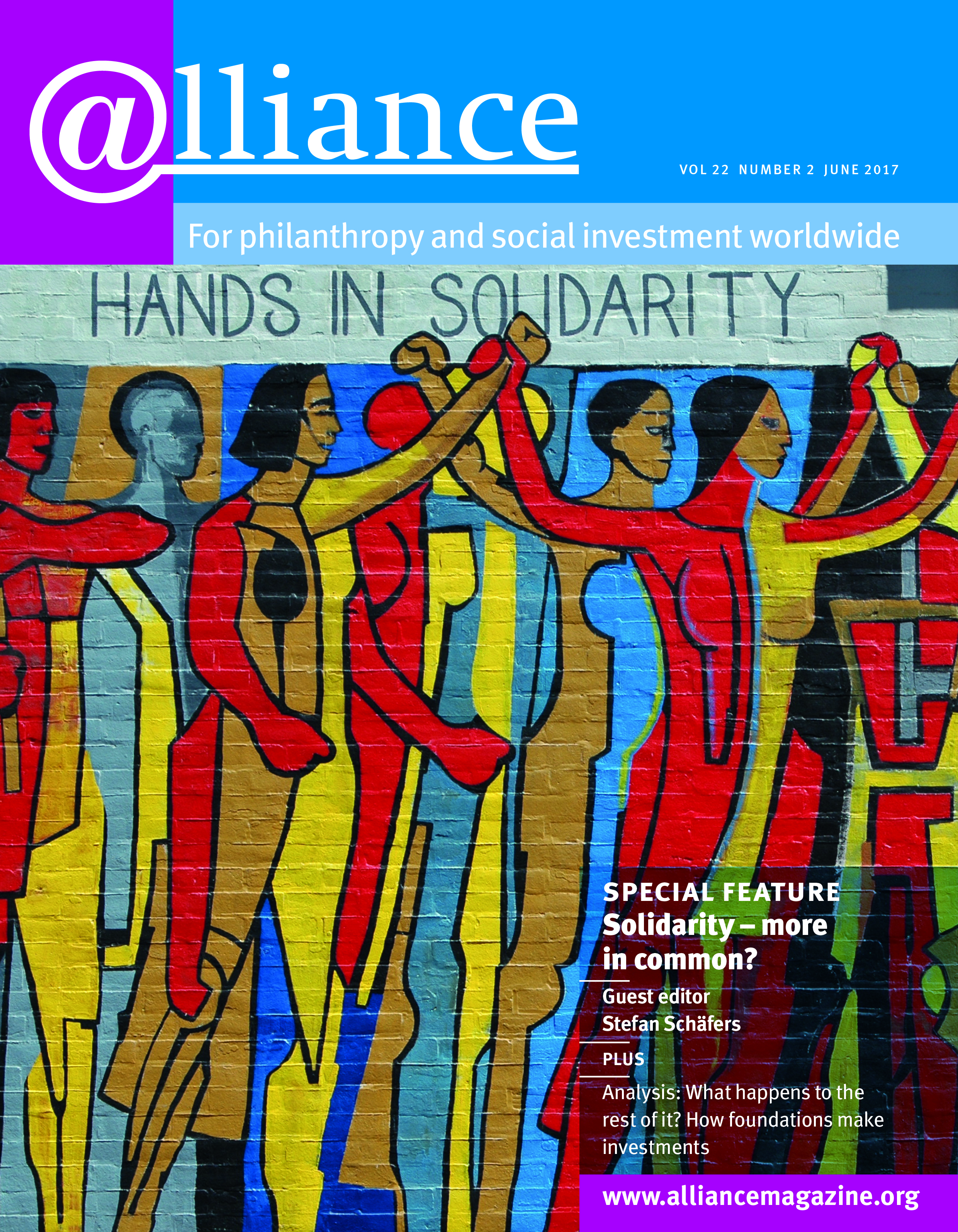Low-risk investment companies that channel a small percentage of their assets into philanthropy – that’s how Clara Miller, president of the Heron Foundation described foundations in an interview with Alliance a year ago. It’s on that ‘small percentage’ that the spotlight generally falls. What happens to the rest of it? How are those investments made and in what, and – perhaps the most obvious question of all – shouldn’t more of them be made to serve foundations’ ultimate purpose?
This article deals with foundations with investable assets, so many corporate foundations, for example, lie outside its scope. The same goes for countries like India where there are strict rules governing foundation investments and where the sector is young and, as Amitabh Behar of the National Foundation for India observes, ‘has little experience in terms of making full investment policies but I am sure the question will confront us soon’.
It also excludes programme-related investments. Though the distinctions may be hard to maintain in practice, what we are concerned with is what are variously called environmental, social and governance (ESG) investment and social investment, impact investment and mission-related investment (MRI).
How do foundations make investments?
For most, it’s likely to be a mix of internal and external expertise. THE VELUX FOUNDATIONS in Denmark, for instance, do ‘some direct investments in-house but predominantly work with a number of investment managers who do investments on our behalf’, says Anders Lyngaa Kristoffersen.
Similarly, the UK’s Joseph Rowntree Charitable Trust’s investment policy statement notes that the trust employs ‘the services of an independent investment adviser and an independent performance measuring agency’, but ‘we also ensure that individuals with relevant expertise serve on our Investment Committee’.
Behind closed doors
Generally speaking, foundations are coy about their investments.
According to a recent article in Non-Profit Chronicles, only two of the ten largest US foundations – the MacArthur Foundation and the WK Kellogg Foundation – publish investment returns on their websites.

Can foundations thrive outside Clara Miller’s terrarium? (See her paper Building a foundation for the 21st century –
http://tinyurl.com/miller-terrarium
The article posits that the reason may be indifferent financial performance, since the combined – and costly – expertise of their advisers both internal and external, ‘delivers investment returns that lag behind market indexes’.
There may be other, deeper reasons too. In 2015, the UK’s Guardian newspaper ran a story headed, ‘Revealed: the Gates Foundation’s $1.4 billion in fossil fuel investments’, alleging that the foundation held investments in some of the world’s biggest – and most notorious – fossil fuel companies, including BP, Anadarko Petroleum, and the Brazilian mining company, Vale.
The foundation ‘declined to comment on fossil fuel divestment and said all investment decisions were taken by a separate entity, the Asset Trust, which… never makes public comments’.
Yet, in their 2015 annual letter, Bill and Melinda Gates said: ‘The long-term threat [of climate change] is so serious that the world needs to move much more aggressively – right now – to develop energy sources that are cheaper, can deliver on demand, and emit zero carbon dioxide.’
Contrast this with the remark made by Clara Miller in the Alliance interview last year: ‘For us at Heron, it was a logical step to make an investment policy statement that basically said if a foundation is making money on the very things that are undermining its success, it’s in breach of its fiduciary duty of obedience to mission.’
It’s tempting to conclude that those who are most open about the matter are those who feel confident of public approbation.
Investment screening
How many foundations screen investments either negatively (not investing in companies with, for instance, questionable employment practices, or whose products are deleterious to human wellbeing) or positively (investing in companies whose products, for instance, increase human welfare or who use fair employment practices)?
Carola Carazzone says that around three-quarters of Assifero’s 100 members have investable assets, and roughly half of them undertake some form of screening – ‘mainly negative screening’.
At a minimum, most will screen investments for what Chris Varco of Cambridge Associates calls ‘the traditional negative exclusions’ like tobacco or weapons. ‘We conduct both negative and positive screening of all relevant publicly-listed investments,’ says Anders Lyngaa Kristoffersen. The King Baudouin Foundation (KBF) in Belgium applies ‘a best in class approach… combined with some exclusion criteria, based on the exclusion list of the Norwegian Pension Fund and controversial weapons’, says Jan Vander Elst. ‘The Norwegian Pension Fund’s list combines both product-based and behaviour-based exclusions. The former includes the tobacco and coal sector,’ though the fund does not exclude oil since its basis is revenues from Norway’s petroleum industry.
Jan Vander Elst applies ‘a best in class approach… combined with some exclusion criteria, based on the exclusion list of the Norwegian Pension Fund and controversial weapons’.
The practice is by no means universal, though. Carola Carazzone of Assifero in Italy, around three-quarters of whose 100 members have investable assets, calculates that roughly half of them undertake some form of screening – ‘mainly negative screening’. Last year, Assifero ‘adopted a Charter of Accountability Principles which requests this and also mission-related investments in order to pull the practice further among our members’.
And screens have their limits. ‘With an endowment invested almost entirely in funds assembled by outside managers, screens are a less effective tool,’ a spokesperson for the Ford Foundation told us.
Moreover, there are times when foundations will ignore popular sentiment when making investments. The Körber Foundation in Germany, for example, makes no bones about continuing to invest in tobacco because that’s where its money came from in the first place. Founder Kurt Körber ‘earned most of his money from a machine that could produce filter cigarettes… we don’t have a problem with tobacco’, said Thomas Paulsen in a recent interview with Alliance.
The fossil fuels debate
At other times, moral and financial considerations will overlap, as the fossil fuels debate illustrates. Ellen Dorsey of the Wallace Global Fund has said categorically: ‘If you own fossil fuels, you own climate change.’
Ellen Dorsey of the Wallace Global Fund has said categorically: ‘If you own fossil fuels, you own climate change.’
It’s a view that’s finding more and more favour. At the time of writing, the Divest Invest Pledge founded by Wallace had 140 signatories including THE VELUX FOUNDATIONS. Moreover, as well as their moral reputation, investors in the area might lose their money, too. Chris Varco notes: ‘There’s clearly a potential negative risk in owning fossil fuel companies that may be worth zero… it’s hard to argue with the fact that if we are to meet the two degrees warming targets, we need to keep 80 per cent of known fossil fuels in the ground.’
The next great innovation for advancing social good
But exclusions and divestment aside, how far are foundations’ invested assets used to generate returns that in themselves will either advance their own missions or contribute to the general good?

Can foundations thrive outside Clara Miller’s terrarium? (See her paper Building a foundation for the 21st century – http://tinyurl.com/miller-terrarium
Famously, the Heron Foundation is devoting all of its assets to impact investing.
Few have gone this far yet.
Signatories of the Divest Invest Pledge are invited to devote a portion of their portfolio ‘at least 5 per cent’ to ‘climate solutions like clean energy, sustainable agriculture…’ THE VELUX FOUNDATIONS’ aim is that 10 per cent of ‘tied up assets are made up of impact investments by 2020 in addition to the company group’s very substantial investments in solutions that create a more environmentally sustainable world’, says Anders Lyngaa Kristoffersen.
Why? ‘With our limited economic resources, THE VELUX FOUNDATIONS want to contribute to a more environmentally sustainable world as much as we can and if possible we would like to inspire others to follow suit.
‘Mission-related investments allow [The King Baudouin Foundation] to fulfill its mission in a different way,’ says Jan Vander Elst. He adds: ‘One of the advantages… is that you have another mindset, you are obliged to have a different look at the projects as the assessment is not only on the social impact but also on the finance.
Moreover, you can carry some projects further compared to only using grants.’ So far, KBF has taken a ‘case by case approach’ rather than assigning a definite proportion of its assets to mission-related investment.
In 2015, the Treebeard Trust in the UK began using 20 per cent of its assets for social investment. ‘Large enough to be material,’ says the trust’s Barnaby Wiener who is also a champion of Big Society Capital’s Get Informed: Social investment for Boards campaign, ‘but not so large as to transform the risk profile of our portfolio.
At the time we were conscious that we were stepping into unknown territory, so we wanted to give ourselves a chance to take stock, and we also anticipated that it would take several years to get to 20 per cent.’ In fact, it’s happened much quicker than expected and Treebeard’s new target ‘is to have 50 per cent of our assets invested for impact’.
Into all this comes Ford’s latest announcement that it will devote $1 billion – a twelfth of its endowment – over the next 10 years to impact investment. ‘We are making this commitment because we believe mission-related investments have the potential to become the next great innovation for advancing social good,’ says Ford president Darren Walker.
Giorgio Righetti of ACRI says: ‘Foundations are more than happy to invest in MRI when there are market opportunities that match their investment screening criteria.’
It is also consciously setting an example. ‘As one of the major institutional investors, the Ford Foundation hopes to encourage other foundations, endowments, pension funds, family offices etc to join the growing impact investing movement,’ a spokesperson for the foundation told us.
And the field has space for it. Despite its apparent merits and despite the contributions of the foundations mentioned above, impact investing or mission-related investing is still a minority occupation. Chris Varco says that Cambridge Associates’ most recent annual survey showed that ‘about 150 (10 per cent) of our clients are meaningfully integrating mission-related investing in their investment process’, while Carola Carazzone estimates that ‘less than 10 per cent’ of Assifero’s members are practising mission-related investing.
Against this, it’s fair to point out that the members of ACRI, the other main Italian grantmakers’ association, devote 10 per cent of their investments to mission-related investing, according to director general Giorgio Righetti. ACRI’s members tend to have more assets since they include the Italian banking foundations.
Anders Lyngaa Kristoffersen notes: ‘impact investments… represent an emerging investment area so few managers have long-standing experiences in the field and hence finding good investment opportunities can be hard and resource-demanding.’
So why isn’t it more widespread?
Why isn’t everyone doing it? Are foundations worried that their returns will suffer and that the amount of money available for grantmaking – where they traditionally see their main virtue – would therefore be smaller? This argument is becoming less and less cogent. Chris Varco notes ‘a growing body of evidence to suggest that taking a sustainable lens that aligns with the missions of many of our foundations can add alpha [the excess return of a fund over the return of a benchmark index].
You could look at the returns of some very well-known sustainable investment funds that would back that up.’ Similarly the Joseph Rowntree Charitable Trust’s experience over the last 30 years ‘underpins our belief that we do not necessarily need to sacrifice financial returns to invest ethically or responsibly’.
‘Is there a risk that our impact investments fail to deliver the desired returns?’ asks Barnaby Wiener. ‘Of course – but the same is true for all our investments. And looking at current valuations in the public markets, I actually think our impact investments stack up very well indeed.’
Another deterrent may be inexperience.
‘[The sector] has little experience in terms of making full investment policies but I am sure the question will confront us soon.’ Amitabh Behar, National Foundation for India
Jan Vander Elst notes that it’s ‘not always easy to assess the MRI… to analyse a deal, to do a due diligence’, while ‘having a sufficient pipeline of (possible) deals could be a hurdle’. Giorgio Righetti of ACRI also raises the deal-flow question: ‘Foundations are more than happy to invest in MRI when there are market opportunities that match their investment screening criteria.’
Anders Lyngaa Kristofferson also notes that ‘impact investments… represent an emerging investment area so few managers have long-standing experiences in the field and hence finding good investment opportunities can be hard and resource-demanding’.
Attitude
It may simply be habits of thought that are slow to change. ‘I think sometimes people are focusing on traditional negative exclusions and how that may have impeded their returns,’ says Chris Varco, ‘rather than looking at the positive of mission-related investing.’
Barnaby Wiener, too, believes ‘mindset’ to be a big obstacle. ‘This notion that profit and purpose cannot co-exist runs pretty deep.’ Carola Carazzone says much the same, as does Matthias Fiedler, chair of ethical investment at Edge Funders: ‘The main reason in my view, is that many foundations don’t see their capital as a lever for change. The only see it as a vehicle to generate returns.’
‘But it’s changing,’ believes Barnaby Wiener, ‘and it will continue to change – because it has to. Solving complex social and environmental problems requires capital and innovation.’
Data, push and pull, and the Ford motor
‘But it’s changing,’ believes Barnaby Wiener, ‘and it will continue to change – because it has to. Solving complex social and environmental problems requires capital and innovation.’
‘When we’re talking about the main endowments of foundations,’ says Chris Varco, ‘I think there is a growing realization that there are opportunities for taking extra-financial considerations in your investments.’ One of the reasons for this realization is improved data: ‘There’s only been decent ESG and sustainability data as a tool for investing in public equities over the last five years.’
Chris Varco says: ‘It’s hard to argue with the fact that if we are to meet the two degrees warming targets, we need to keep 80 per cent of known fossil fuels in the ground.’
What will make it grow faster, he believes, is ‘an expanded opportunity set, which is happening all the time. There’s a big opportunity set in emerging markets as it grows and as managers start to build up a track record of strong performance… and the underlying economics of sustainability will improve.’
As well as the ‘pull’ of increasing opportunity, what he calls ‘the tail risk’ of non-MRIs is growing. ‘In this interconnected world, there’s a growing risk of not doing things in an appropriate manner… Look at the Rana Plaza incident in Bangladesh and the subsequent exposé about the supply chains of cheap textiles for western companies.
The licence of companies to operate is increasingly being governed by ESG behaviour.’ Finally, Ford’s commitment – the largest so far by a foundation to MRI – will be significant not just for the amount of money it represents, but because of the influence it is likely to have on other foundations.
So bit-by-bit the conditions are beginning to favour impact investing, with the weight of public expectation behind, the lure of better returns and more known market quantities in front. ‘Slowly but surely,’ as Matthias Fiedler puts it. What else would help to speed it up?
The ‘open-plan’ foundation?
Perhaps mindset is the key. It’s interesting to note that both Treebeard and Heron are not just dividing their assets differently, they are really pioneering a new approach to running a foundation, in which every use of assets is a form of investment (grants are investments where the return is purely social), and all investments have a social impact (positive or negative).
The implications of this are considerable. Instead of being assigned to separate pots, all foundation income and expenditure runs along a continuum. Investment and programme staff rub shoulders in a sort of ‘open plan’ concept.
Why wouldn’t foundations use their investable assets in ways that produce social good or further their own missions? Or both? The obstacles are being progressively removed, and the motives are compelling.
And as Ellen Dorsey remarked on accepting the Brave Philanthropy Award on behalf of the signatories of the Divest Invest Pledge in Bogota last year: ‘We receive charitable tax status because we serve the social good, and our investments should as well. Philanthropy isn’t just any investor.’ From the outside, it looks like a no-brainer. When you have a hammer handy, why would you knock in a nail with the heel of your shoe?
Alliance would like to thank the following for contributing to this article:
Amitabh Behar, executive director, National Foundation for India
Anders Lyngaa Kristoffersen, head of impact investments, THE VELUX FOUNDATIONS, Denmark
Barnaby Wiener, trustee, Treebeard Trust, UK
Carola Carazzone, secretary general, Assifero, Italy
Chris Varco, senior investment director, Cambridge Associates
Giorgio Righetti, director general, ACRI, Italy
Jan Vander Elst, head of finance, King Baudouin Foundation, Belgium
And to Danmarks-fonde and Big Society Capital
Andrew Milner is associate editor of Alliance. Email am@andrewmilner.free-online.co.uk.








Comments (0)